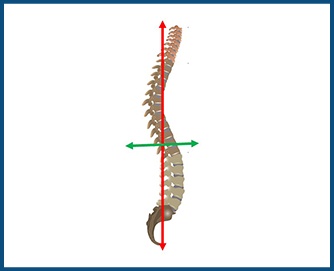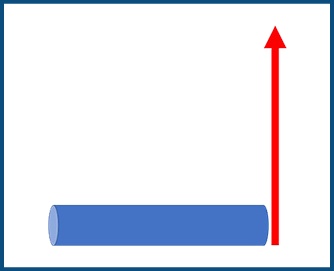Not much has been written on the biomechanics of lumbar injuries after a fall. However, lumbar fall injuries are not enigmas. A simple understanding of physics and anatomy is sufficient to draw a reasonable conclusion regarding the causality of lumbar injuries sustained by a fall.
Force magnitude
In physics a Force is described as having a magnitude. The magnitude of a Force is described by the equation Force=mass x acceleration, (F=ma), where m=the weight of the object with the Force acting on it and “a,” in a fall, is the acceleration due to gravity. In a fall this can be an important variable and explains why heavier or obese patients may sustain more severe injuries. Quite logically, they hit the ground with greater Force.
Force vector
A Force also has a direction. This is called a Vector. For example, if an object is falling straight down the Vector of Force is traveling at a 90 degree angle to the ground. However, an object in a fall may be oriented at varying angles relative to the ground. As a result, there will be a component of Force acting on the longitudinal axis (the up and down axis) of the object that varies depending on the angle between the longitudinal axis of the object and the ground. For example, if the longitudinal axis of the object is oriented straight up and down, the entire Vector of Force will act on the object (figure 1).
Figure 1
The Force Vector (arrow) applied on an object (cylinder) when the longitudinal axis is straight up and down. The entire Force acts on the objects.
If the longitudinal axis of the object is completely parallel to the ground during a fall, then there will be no component of Force Vector acting on the longitudinal axis of the object (figure 2).
Figure 2
An object falls with the longitudinal axis (cylinder) parallel to the floor. There is no Force (arrow) applied to the longitudinal axis.
Finally, if the longitudinal axis is somewhere in between, there will be a component Vector of Force, smaller than the up and down Vector, that acts on the longitudinal axis of the object (figure 3).
Figure 3
When the longitudinal axis (cylinder) is at an angle to the floor, there is a component of the Force (green arrow) that is applied to the axis. This is smaller than the up and down Force component (red arrow)
Forces and the spine
Understanding how Force Vectors work is critical in understanding the Forces that act on the spine in a fall. Consider the spine as having a longitudinal up and down axis extending from the neck all the way down to the tail bone and a transverse axis extending from front to back (figure 4).

Figure 4
The spinal longitudinal (red arrows) and transverse (green arrows) axes.
If one were to fall with their spine oriented exactly ninety degrees to the floor (straight up and down) the entire Force of the fall (mass of the patient x acceleration due to gravity) would be felt on the longitudinal axis of the spine, assuming no cushioning effect from overlying soft tissues. If one were to fall flat on their back, with the spine oriented parallel to the floor, little or no Force would be felt on the longitudinal axis of the spine. The force would be felt on the transverse axis, or the front to back axis. If the spine was oriented at any degree between zero and 90 degrees to the ground at the time of the fall, there would be some component Vector of Force applied to the longitudinal spine axis. The closer the long axis of the spine is to 90 degrees relative to the ground, the greater the Force on the longitudinal axis. The remaining force would be applied to the spine transverse axis.
The longitudinal axis of the spine consists of the vertebral body and its disc cushion lying between vertebral bodies. A component Force Vector along the longitudinal axis can cause a fracture of the vertebral body or a rupture or tear of the disc. Even a fall flat on the back, where there is no Force along the longitudinal axis, can cause spinal injuries. In this case the Force is applied as a Vector 90 degrees to the spine longitudinal axis. This Force can fracture spinous processes, impact and sheer spinal facet joints and cause sheer forces between vertebra and disc. Before shoulder restraints came about Forces perpendicular to the spine axis used to cause crippling spinal injuries in car accidents.
Effects of flexion on landing
It’s important to note that often the lumbar spine will be flexed during a fall. This occurs because one will often fall on the buttocks or hips while maintaining a spinal orientation that is at some degree of angulation to the ground. As a result, there is a Vector of Force that is applied along the longitudinal spine axis. That Vector will be felt along the disc, which can be more susceptible to injury than the vertebra. At L5/S1 and L4/5 the posterior disc annulus fibers (disc lining) will be stretched due to the flexion or bending of the spine at landing. The resultant Vector Force component along the spine axis will act on the stretched annulus. The annulus is least resistant to strain when stretched. Depending on the amount of Force, the conditions for a tear of the annulus and subsequent disc herniation may easily be met.
Conclusion
Fall injuries are common and they do cause spinal injuries. The mechanism of injury in these cases can be logically understood by applying basic principles taught in High School Physics. Understanding these principles and clearly explaining them to a jury is beneficial in establishing the cause of an injury and the consequence of the injury mechanism.
John Finlay, MD
The views expressed are the personal views of the author and do not represent the views of The Brain, Spine and Joint Group, its managers, affiliates, partners, employees or its clients. Furthermore, the information provided by the author is not intended to be expert or legal advice.
The content of this newsletter is confidential. It is strictly forbidden to copy, forward, reveal the content of or share any part of this newsletter content with any third party, without a written consent of The Brain, Spine and Joint Group. If you received this newsletter, or a link to it, by mistake, please message



